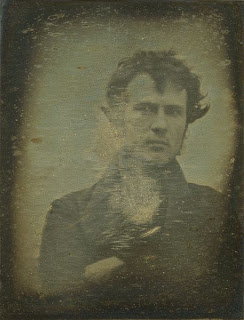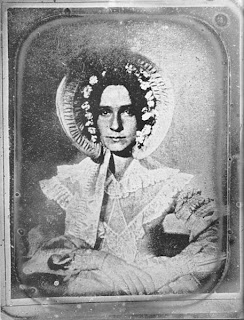Robert Cornelius was an American pioneer of photography. At school his main interest was in chemistry. After school in 1831 he started working for his father specialising in silver plating and metal polishing. Just as he was beginning to get famous for his work in his fathers silver plating industry, he was approached by Joseph Saxton to help him silver plate his daguerrotype. Working with Saxton is what started Cornelius' interest in photography. In 1839 he took a portrait of himself. This was one of the first ever photographs with a human in it. It was one of the starting points of portraiture in photography.

John William Draper 1811 - 1882 :
John William Draper was an American (English born) scientist, philosopher, historian, chemist, physician and photographer. He did lots of work in photochemistry, and made advancements that made portraiture more possible. In 1840 he took the first clear photograph of a woman - his sister Dorothy Catherine Draper.

This photograph was taken on a 65 second exposure by sunlight.
Also in 1840, Draper created the first clear photograph of the Moon.
Richard Beard 1801 - 1885 :
Richard Beard was an English entrepreneur and photographer who helped establish professional photography in the UK.60's Fashion : Sixties fashion photography changed a lot when people could use compact cameras. The invention of roll film meant that people could shoot quickly and photography didn't have to be the long, slow process that it was before. This meant that photographers could be more spontanious with their shots and not think about them too much. Before, they would have to plan out a shot exactly, and position their subject to sit very still for a long time. Now they could use faster shutter speeds and move their model around. They could interract with their model more since the model wasn't having to sit completely still for ages, this would create better shots because there was a more intermate relationship between photographer and subject. A Smaller kit meant that photographers could move out of the studio because it was easier for them to carry it around. This was the huge turning point of the 'Swinging Sixties' photography because photographers were able to take their models on location and create some interesting and abstract shots with their models infront of something other than a plain studio background. Because the photographers were now able to move around, they could create different compositions and move right up to their model for more close up shots - these shots showed more personality in the models. Before then, models were just used as 'coathangers' or 'manakins' to display clothing, but now they were able to develop their own personality, which would then make them more famous and they would be seen as a celebrity/iconic figure rather than just something that displays clothes.
David Bailey :
David Bailey is considered to be one of the best and greatest British Photographers. He was one of the iconic photographers during the 'Swinging Sixties' era.

No comments:
Post a Comment